Input interpretation

1, 1, 1-trichloroethane
Chemical names and formulas
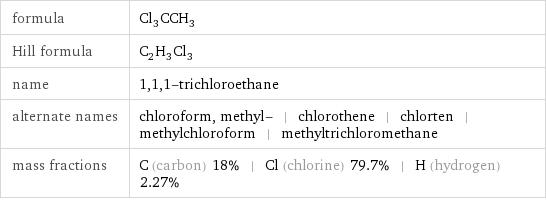
formula | Cl_3CCH_3 Hill formula | C_2H_3Cl_3 name | 1, 1, 1-trichloroethane alternate names | chloroform, methyl- | chlorothene | chlorten | methylchloroform | methyltrichloromethane mass fractions | C (carbon) 18% | Cl (chlorine) 79.7% | H (hydrogen) 2.27%
Lewis structure
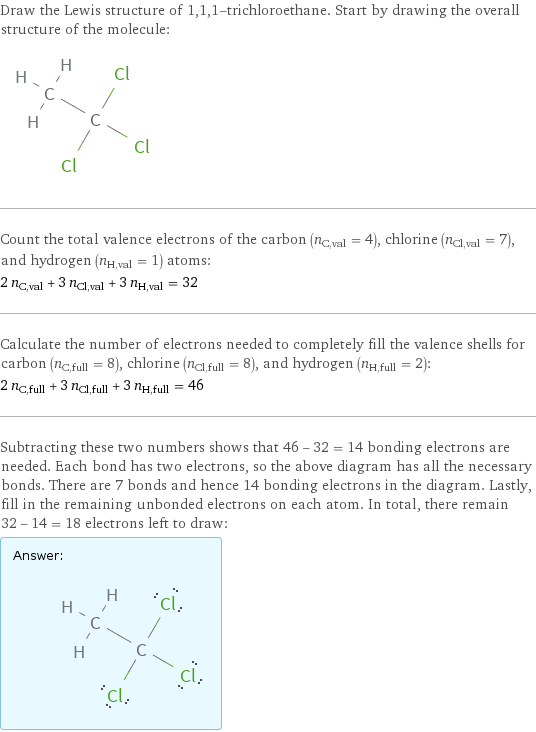
Draw the Lewis structure of 1, 1, 1-trichloroethane. Start by drawing the overall structure of the molecule: Count the total valence electrons of the carbon (n_C, val = 4), chlorine (n_Cl, val = 7), and hydrogen (n_H, val = 1) atoms: 2 n_C, val + 3 n_Cl, val + 3 n_H, val = 32 Calculate the number of electrons needed to completely fill the valence shells for carbon (n_C, full = 8), chlorine (n_Cl, full = 8), and hydrogen (n_H, full = 2): 2 n_C, full + 3 n_Cl, full + 3 n_H, full = 46 Subtracting these two numbers shows that 46 - 32 = 14 bonding electrons are needed. Each bond has two electrons, so the above diagram has all the necessary bonds. There are 7 bonds and hence 14 bonding electrons in the diagram. Lastly, fill in the remaining unbonded electrons on each atom. In total, there remain 32 - 14 = 18 electrons left to draw: Answer: | |
3D structure

3D structure
Basic properties
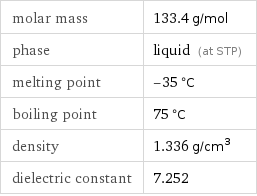
molar mass | 133.4 g/mol phase | liquid (at STP) melting point | -35 °C boiling point | 75 °C density | 1.336 g/cm^3 dielectric constant | 7.252
Liquid properties (at STP)
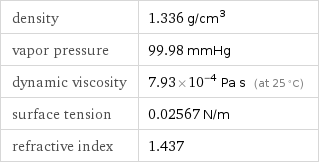
density | 1.336 g/cm^3 vapor pressure | 99.98 mmHg dynamic viscosity | 7.93×10^-4 Pa s (at 25 °C) surface tension | 0.02567 N/m refractive index | 1.437
Units

Thermodynamic properties

specific heat capacity c_p | gas | 0.6994 J/(g K) | liquid | 1.082 J/(g K) molar heat capacity c_p | gas | 93.3 J/(mol K) | liquid | 144.3 J/(mol K) specific heat of formation Δ_fH° | gas | -1.082 kJ/g molar heat of formation Δ_fH° | gas | -144.4 kJ/mol molar heat of vaporization | 32.5 kJ/mol | specific heat of vaporization | 0.244 kJ/g | molar heat of combustion | 1442 kJ/mol | specific heat of combustion | 10.81 kJ/g | molar heat of fusion | 2.35 kJ/mol | specific heat of fusion | 0.0176 kJ/g | thermal conductivity | 0.101 W/(m K) | critical temperature | 584 K | critical pressure | 4.495 MPa | (at STP)
Chemical identifiers
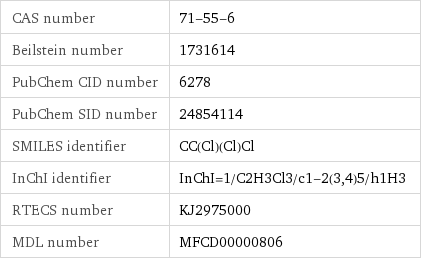
CAS number | 71-55-6 Beilstein number | 1731614 PubChem CID number | 6278 PubChem SID number | 24854114 SMILES identifier | CC(Cl)(Cl)Cl InChI identifier | InChI=1/C2H3Cl3/c1-2(3, 4)5/h1H3 RTECS number | KJ2975000 MDL number | MFCD00000806
NFPA label

NFPA label

NFPA health rating | 2 NFPA fire rating | 1 NFPA reactivity rating | 0
Safety properties

flash point | -1 °C autoignition point | 500 °C lower explosive limit | 7% (concentration in air) upper explosive limit | 16% (concentration in air)

DOT hazard class | 6.1 DOT numbers | 2831
Toxicity properties

odor | chloroform-like lethal dosage | 10300 mg/kg (oral dose for rats) short-term exposure limit | 2450 mg/m^3 threshold limit value | 350 ppmv

probable lethal dose for man | 1 L (liter) long-term exposure limit | 1900 mg/m^3 (over 8 hours) RTECS classes | agricultural chemical and pesticide | tumorigen | mutagen | reproductive effector | human data | primary irritant